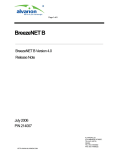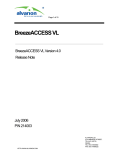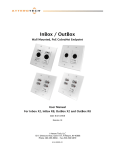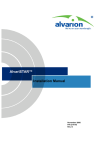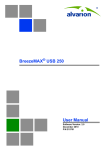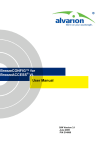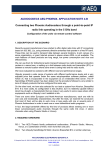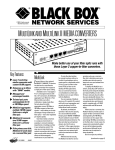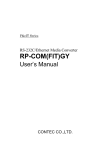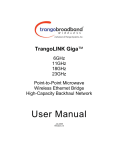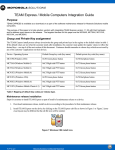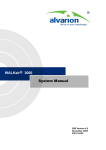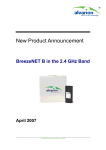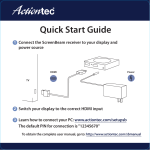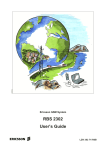Download BreezeACCESS VL Release Notes
Transcript
Page 1 of 7 BreezeNET B BreezeNET B Version 4.5 Release Notes August 2007 ALVARION LTD. 21A HABARZEL STREET, TEL AVIV, 69710, ISRAEL TEL: 972-3-6456262 FAX: 972-3-6456222 HTTP://WWW.ALVARION.COM Page 2 of 7 1. Introduction BreezeNET B version 4.5 introduces new features and support of new country codes. For more details refer to the applicable sections in the System Manual and Country Codes documents. 2. Frequency bands The currently supported frequency bands: 5.8 GHz Band: 5.725–5.875 GHz (Universal Country Code with HW Revision C)/5.725–5.850 GHz (all other Country Codes) 5.4 GHz Band: 5.470–5.725 GHz 5.2 GHz Band: 5.150–5.350 GHz 5.3 GHz Band: 5.250–5.350 GHz 3. New Country Codes (Regulatory Domains) BreezeNET B SW version 4.5 complies with the regulatory requirements of the following new Country Codes for HW Revision C and higher: FCC 5.4 GHz Country Code, including DFS support Australia 5.4 GHz and 5.8 GHz Country Codes In addition, the following improvements were introduced: Support of DFS in the FCC 5.3 GHz band Universal 5.8 GHz Country Code can support the entire band from 5.725 to 5.875 GHz (was previously 5.725 to 5.850 GHz). UK 5.8 GHz Country Code was enhanced to enable 40 MHz channels and a higher EIRP of 36 dBm. Note that after upgrade to SW version 4.5, the Re-Apply Country Code Values feature must be activated for these changes in existing Country Codes to take effect. ALVARION LTD. 21A HABARZEL STREET, TEL AVIV, 69710, ISRAEL TEL: 972-3-6456262 FAX: 972-3-6456222 HTTP://WWW.ALVARION.COM Page 3 of 7 4. New Features and Improvements Increased Reliability for Ethernet Multicasts and Broadcasts, Better Performance for Video over IP Traffic To fully exploit the benefits of operating in a point-to-point link, Ethernet broadcasts/multicasts are now transmitted by the BU to the wireless link as unicasts. This allows utilizing the acknowledgement and retransmission mechanism also for these frames, providing increased reliability with a lower number of lost packets. Increased Size of Entries in Forwarding Table The maximum number of entries in the Forwarding table has been increased from 1024 to 4096. Serial Number and ATE Status Information for Easier Inventory Control The unit’s Serial Number and ATE Test Results details are now available in both Telnet and SNMP. Improved Search Mechanism in the MAC Address Database The improved search mechanism provides enhanced and faster searching performance, especially when the database contains a relatively large number of entries. Improved Aging Mechanism for the RBs The decision algorithm used for removal of the RB from the BU’s Association Database has been improved. The current criteria for removing an RB from the list are: A SNAP frame is received from another BU indicating that the RB is now associated with the other BU. The RB failed to respond to 100 consecutive data frames transmitted by the BU and is considered to have "aged out". During the last 6 minutes (or more) the RB failed to respond to the certain frames that typically are transmitted by the BU every 10 seconds. Since the sampling interval for this state is 10 minutes, it means that the decision to remove the RB from the Association Database will take place between 6 to 16 minutes from the time the RB stopped responding to these “keep-alive” frames. ALVARION LTD. 21A HABARZEL STREET, TEL AVIV, 69710, ISRAEL TEL: 972-3-6456262 FAX: 972-3-6456222 HTTP://WWW.ALVARION.COM Page 4 of 7 Reapplying the Country Code Parameters The Country Code Re-apply feature enables verifying that after loading an updated Country Code the new values will take effect. Note that following activation of the Re-apply Country Code Values option, all parameters that are affected by the Country Code (frequency parameters, transmit power parameters, DFS operation, modulation level parameters, burst mode parameters) revert to their factory default values and must be re-configured. Better Default Values for Noise Immunity The default value for the Pulse Detection Sensitivity has been changed to Low (unless DFS is enabled, forcing the value to High). Note that in units where DFS is not used, after upgrade to version 4.5 the value will be forced to Low regardless of its previous value. 5. BreezeCONFIG Configuration Utility Version 4.5 A new version of BreezeCONFIG that supports all the new features of BreezeNET B version 4.5 is provided with the product. BreezeCONFIG SW will also be available in the customer service section of the Alvarion web site. 6. Documentation The information in the release notes is complementary to the product documentation, provided with the products. BreezeNET B documentation includes the System Manual for BreezeNET B version 4.5, User Manual for BreezeCONFIG version 4.5, installation support documents, and release notes. All the documentation, including the latest release notes, is available in the customer service section of the Alvarion web site. 7. Compatibility and Interoperability Version 4.5 is fully compatible with versions 2.0, 3.0, 3.1 and 4.0. Nevertheless, it is recommended to always upgrade existing equipment to the latest version. In links where the two units run different SW versions the performance will be determined by the unit with the lower SW version. The SW package will be available in the customer service section of the Alvarion web site. ALVARION LTD. 21A HABARZEL STREET, TEL AVIV, 69710, ISRAEL TEL: 972-3-6456262 FAX: 972-3-6456222 HTTP://WWW.ALVARION.COM Page 5 of 7 8. Important Notes Although minimum output power is defined as -10 dB when configuring the Tx Power manually, when ATPC is enabled the RB’s output power may be less than this minimum. Extra care should be taken when configuring VLAN management and management IP filtering in order not to lose connectivity with unit. In case of connectivity loss, use the “restore default parameters” application to reset to factory values. Upon downgrade from version 4.5 to version 3.0 or lower, all the information in the new Network Management IP Address Ranges table will be lost. Hence, management access may be lost if the unit was managed from an IP address that is on a subnet defined in the new tables. When upgrading from version 3.0 or lower to version 4.5, the high/low packet classification settings according to the old VLAN Priority Threshold or IP Precedence Threshold parameters will be lost. The new parameters are forced to the default value of 7, meaning no prioritization. When Wireless Link Prioritization feature is activated in BreezeNET B100, the prevention of Low Priority Traffic Starvation is automatically disabled. Remote changes of the Maximum Modulation Level in an RB while Adaptive Modulation is disabled may lead to lose of connectivity with the unit. The recommended workaround is to enable Adaptive Modulation, reset the unit to apply the change, and then change the Maximum Modulation Level. Adaptive Modulation may not converge to best modulation in some setups with high variance in noise levels. In these cases better performances may be achieved with manual modulation settings (Adaptive Modulation Disabled). Upon upgrade to SW version 4.5 from a version 3.1 or lower the FTP Client IP Address and Subnet Mask no longer exist as configurable parameters and the unit's IP parameters are used instead. Upon downgrade from SW version 4.5 to version 3.1 or lower the FTP Client IP Address of the unit is automatically set to the same value as the IP Address of the device. In this case following warning message appears: *** WARNING: Same 'Unit IP Address' and 'FTP Client IP Address'! *** ALVARION LTD. 21A HABARZEL STREET, TEL AVIV, 69710, ISRAEL TEL: 972-3-6456262 FAX: 972-3-6456222 HTTP://WWW.ALVARION.COM Page 6 of 7 *** 'FTP Client IP Address' ignored until change and reset! *** After downgrade it is recommended changing the FTP Client IP Address to 1.1.1.3 and the FTP Server IP Address to 1.1.1.4. SNMP management was checked with SNMPC version 5.1.11e. 9. Limitations & Known Issues Sensitivity may change slightly as a function of frequency (+/-2dB). Transmission power accuracy is +/-1dB above 8dBm @ antenna port (typical condition). At lower levels the accuracy is +/-3dBm, never contradicting regulations. At very low levels the use of ATPC may cause significant fluctuations in the power level of the transmitted signal. When operating at such low levels, it is recommended to disable the ATPC Option in the RB and to set the Transmit Power parameter to the average Tx Power level before the ATPC was disabled. For full compliance with FCC regulations, the following requirements should be followed in units using a 20 MHz bandwidth: In units HW Revision B, if you wish to include frequency channel 5270 MHz in the set of frequencies to be used, then the Transmit Power parameter in the BU, and the Maximum Tx Power parameter in the RB, should not be set to a value above “17-Antenna Gain”. If there is a need to use a higher value for these parameters, this frequency should not be used. In units with HW Revision C, if you wish to include one or more of frequency channels 5270, 5275 and 5330 MHz in the set of frequencies to be used, then the Transmit Power parameter in the BU, and the Maximum Tx Power parameter in the RB, should not be set to a value above “20-Antenna Gain”. If there is a need to use a higher value for these parameters, this frequency should not be used. For full compliance with FCC regulations, the following requirements should be followed in units using a 40 MHz bandwidth (Turbo Mode): In units with HW Revision B, Frequency channels 5270 and 5280 MHz should not be used. In units with HW rev C, if you wish to include frequency channel 5290 MHz in the set of frequencies to be used, then the Transmit Power parameter in the BU, and the Maximum ALVARION LTD. 21A HABARZEL STREET, TEL AVIV, 69710, ISRAEL TEL: 972-3-6456262 FAX: 972-3-6456222 HTTP://WWW.ALVARION.COM Page 7 of 7 Tx Power parameter in the RB, should not be set to a value above “25-Antenna Gain”. If there is a need to use a higher value for these parameters, this frequency should not be used. If you wish to include frequency channel 5310 MHz in the set of frequencies to be used, then the Transmit Power parameter in the BU, and the Maximum Tx Power parameter in the RB, should not be set to a value above “29-Antenna Gain. If there is a need to use a higher value for these parameters, this frequency should not be used. The maximum Transmit Power (at antenna port) of units using FCC 5.3 GHz and FCC 5.4 GHz Country Codes is 9 dBm. In units with HW Revision B, Burst Mode cannot be activated when using WEP for data encryption. In units with HW Revision B, the Burst Mode option will be “blocked” upon trying to enable it when using WEP for data encryption. This limitation does not apply to units with HW Revision C. The following traps are not fully supported by the Trap Monitor of BreezeCONFIG: Ethernet Broadcast/Multicast Limiter Threshold Exceeded: The number of packets that were dropped is not displayed. Unit Type Changed: The new unit type is not displayed. The MAC address of the unit is displayed in the Associated SU/RB Mac Address column. BreezeCONFIG does not support multiple configurations of frequency parameters and Spectrum Analysis. ALVARION LTD. 21A HABARZEL STREET, TEL AVIV, 69710, ISRAEL TEL: 972-3-6456262 FAX: 972-3-6456222 HTTP://WWW.ALVARION.COM







